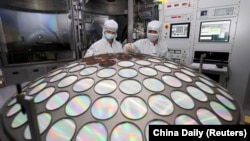U.S. President Joe Biden signed an executive order Wednesday to impose restrictions on U.S. investments in some high-tech industries in China.
Biden’s order could again heighten tensions between the U.S., the world’s biggest economy, and No. 2 China after a period in which leaders of the two countries have held several discussions aimed at airing their differences and seeking common ground.
The new restrictions would limit U.S. businesses’ investments in such high-tech sectors in China as quantum computing, artificial intelligence and advanced semi-conductors, but apparently not in the broader Chinese economy, which recently has been struggling to advance.
Some investments in those sectors will require government notification. Others will be prohibited, but details were not immediately clear. It will apply to new investments only and take effect next year after several rounds of public comment.
Beijing has said it is "gravely concerned" about the order and the impact it could have on global supply chains. In a statement Thursday, China’s Commerce Ministry said the United States was engaging in "de-coupling" under the guise of "de-risking."
The ministry added that China reserves the right to take measures in response.
Bonnie Glaser, managing director of the Indo-Pacific program at the German Marshall Fund of the United States, told VOA, "The series of actions that the Biden administration has announced in this executive order have been expected for some time."
"There have been talks about extending restrictions on … what we call outbound investment into China, because for many years the United States developed a system to screen and place restrictions on certain kinds of investments coming into the United States from China that are linked closely to national security," she said.
In a trip to China in July, Treasury Secretary Janet Yellen told Chinese Premier Li Qiang, "The United States will, in certain circumstances, need to pursue targeted actions to protect its national security. And we may disagree in these instances."
"China has certainly expected that this was coming. This is not a surprise," Glaser said.
She said she would not rule out retaliatory actions by China.
"But if there are actions, I think that they will be targeted, in part because I think China does want to continue the process of engaging with American counterparts and planning for a meeting between China's leader Xi Jinping and American President Joe Biden, at the APEC leaders' summit in November in San Francisco," she said.
National security adviser Jake Sullivan said in April that the U.S., in trying to protect its security interests in the Indo-Pacific region and across the globe, has implemented "carefully tailored restrictions on the most advanced semiconductor technology exports" to China.
"Those restrictions are premised on straightforward national security concerns," he said. "Key allies and partners have followed suit, consistent with their own security concerns."
Sullivan said the measures are not, as Beijing has claimed, a "technology blockade."
In Congress, reaction mostly fell along party lines. Republican Sen. Marco Rubio said the Biden administration's proposal "is riddled with loopholes, explicitly ignores the dual-use nature of important technologies and fails to include industries China’s government deems critical."
Democratic Sen. Bob Casey said Biden's order "acknowledges the urgency of the issue and will allow the U.S. to reduce some of the risks we face from bad actors like China."
Nike Ching, VOA State Department bureau chief, contributed to this report. Some information came from Reuters.








